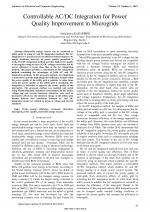| 2/2019 - 13 | View TOC | « Previous Article | Next Article » |
Controllable AC/DC Integration for Power Quality Improvement in MicrogridsKARABIBER, A. |
| Extra paper information in |
| Click to see author's profile in |
| Download PDF |
Author keywords
energy efficiency, harmonic distortion, microgrids, power quality, renewable energy sources
References keywords
energy(21), power(19), quality(12), grid(8), voltage(7), system(6), renewable(6), improvement(6), smart(5), microgrid(5)
Blue keywords are present in both the references section and the paper title.
About this article
Date of Publication: 2019-05-31
Volume 19, Issue 2, Year 2019, On page(s): 97 - 104
ISSN: 1582-7445, e-ISSN: 1844-7600
Digital Object Identifier: 10.4316/AECE.2019.02013
Web of Science Accession Number: 000475806300013
SCOPUS ID: 85066340704
Abstract
Renewable energy sources can be connected to utility grids by using AC and DC integration methods. The AC integration is a practical and cost-effective method thanks to its simple structure; however, its power quality protection is weak. The DC integration method provides high power quality to microgrids owing to extra AC/DC voltage conversion, but its power efficiency is lower than that of the AC integration method. This paper presents a controllable AC/DC integration method combining the advantages of both AC and DC integration methods. In the proposed method, AC integration is activated to provide high integration efficiency at times when the power quality of the utility grid is suitable. At other times when the power quality of the utility grid is unsuitable, DC integration is activated to improve the power quality of the microgrids. The proposed method was modeled and tested using Matlab/Simulink simulation environment. In the model, voltage sag and current harmonic distortion were used as destructive effects for the electrical energy of the utility grid. Results indicate that transitions between AC and DC integration modes are reliable in terms of voltage and current standards. |
| References | | | Cited By |
Web of Science® Times Cited: 5 [View]
View record in Web of Science® [View]
View Related Records® [View]
Updated today
SCOPUS® Times Cited: 7
View record in SCOPUS® [Free preview]
View citations in SCOPUS® [Free preview]
[1] The Stability Criterion and Stability Analysis of Three-Phase Grid-Connected Rectifier System Based on Gerschgorin Circle Theorem, Xie, Lingling, Huang, Jiajia, Tan, Enkun, He, Fangzheng, Liu, Zhipei, Electronics, ISSN 2079-9292, Issue 20, Volume 11, 2022.
Digital Object Identifier: 10.3390/electronics11203270 [CrossRef]
[2] A contingency based energy management strategy for multi-microgrids considering battery energy storage systems and electric vehicles, Afrakhte, Hossein, Bayat, Peyman, Journal of Energy Storage, ISSN 2352-152X, Issue , 2020.
Digital Object Identifier: 10.1016/j.est.2019.101087 [CrossRef]
[3] A comprehensive review on applications of multicriteria decision‐making methods in power and energy systems, Bohra, Shabbir S., Anvari‐Moghaddam, Amjad, International Journal of Energy Research, ISSN 0363-907X, Issue 4, Volume 46, 2022.
Digital Object Identifier: 10.1002/er.7517 [CrossRef]
[4] Optimizing microgrid performance a multi-objective strategy for integrated energy management with hybrid sources and demand response, Moosavi, Mohsen, Olamaei, Javad, Shourkaei, Hossein Mohmmadnezhad, Scientific Reports, ISSN 2045-2322, Issue 1, Volume 15, 2025.
Digital Object Identifier: 10.1038/s41598-025-00118-y [CrossRef]
[5] Smart branch and droop controller based power quality improvement in microgrids, Ray, Papia, Salkuti, Surender Reddy, International Journal of Emerging Electric Power Systems, ISSN 1553-779X, Issue 6, Volume 21, 2020.
Digital Object Identifier: 10.1515/ijeeps-2020-0094 [CrossRef]
[6] Clustering Methods for Power Quality Measurements in Virtual Power Plant, Aksan, Fachrizal, Jasiński, Michał, Sikorski, Tomasz, Kaczorowska, Dominika, Rezmer, Jacek, Suresh, Vishnu, Leonowicz, Zbigniew, Kostyła, Paweł, Szymańda, Jarosław, Janik, Przemysław, Energies, ISSN 1996-1073, Issue 18, Volume 14, 2021.
Digital Object Identifier: 10.3390/en14185902 [CrossRef]
[7] Research on the Control Strategy of Photovoltaic Storage Microgrid and Off-Grid, Zheng, Qiangren, Hu, Lijuan, Xuan, Jingyan, Wu, Ming, Li, Baoju, Ji, Yu, 2025 4th International Conference on Green Energy and Power Systems (ICGEPS), ISBN 979-8-3315-1032-9, 2025.
Digital Object Identifier: 10.1109/ICGEPS65133.2025.11034620 [CrossRef]
Disclaimer: All information displayed above was retrieved by using remote connections to respective databases. For the best user experience, we update all data by using background processes, and use caches in order to reduce the load on the servers we retrieve the information from. As we have no control on the availability of the database servers and sometimes the Internet connectivity may be affected, we do not guarantee the information is correct or complete. For the most accurate data, please always consult the database sites directly. Some external links require authentication or an institutional subscription.
Web of Science® is a registered trademark of Clarivate Analytics, Scopus® is a registered trademark of Elsevier B.V., other product names, company names, brand names, trademarks and logos are the property of their respective owners.
Faculty of Electrical Engineering and Computer Science
Stefan cel Mare University of Suceava, Romania
All rights reserved: Advances in Electrical and Computer Engineering is a registered trademark of the Stefan cel Mare University of Suceava. No part of this publication may be reproduced, stored in a retrieval system, photocopied, recorded or archived, without the written permission from the Editor. When authors submit their papers for publication, they agree that the copyright for their article be transferred to the Faculty of Electrical Engineering and Computer Science, Stefan cel Mare University of Suceava, Romania, if and only if the articles are accepted for publication. The copyright covers the exclusive rights to reproduce and distribute the article, including reprints and translations.
Permission for other use: The copyright owner's consent does not extend to copying for general distribution, for promotion, for creating new works, or for resale. Specific written permission must be obtained from the Editor for such copying. Direct linking to files hosted on this website is strictly prohibited.
Disclaimer: Whilst every effort is made by the publishers and editorial board to see that no inaccurate or misleading data, opinions or statements appear in this journal, they wish to make it clear that all information and opinions formulated in the articles, as well as linguistic accuracy, are the sole responsibility of the author.



